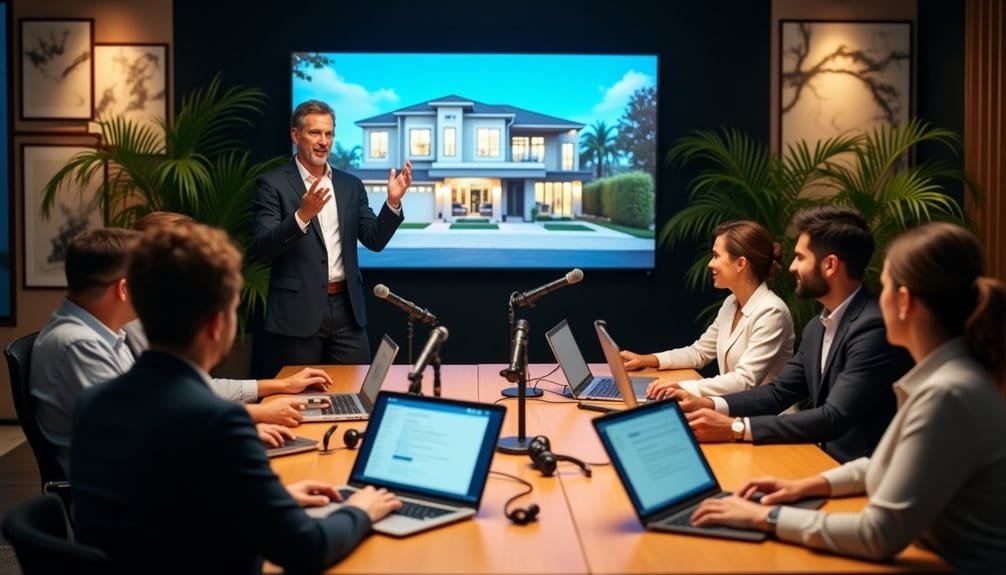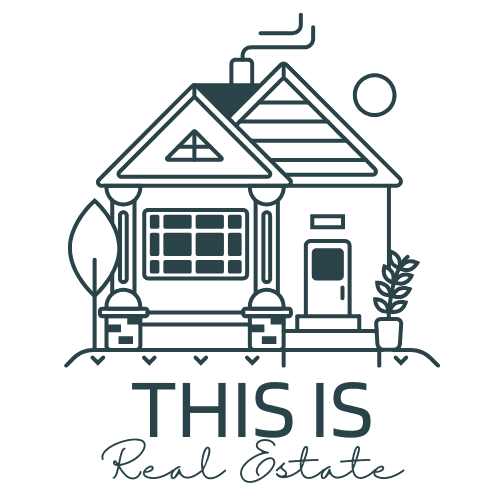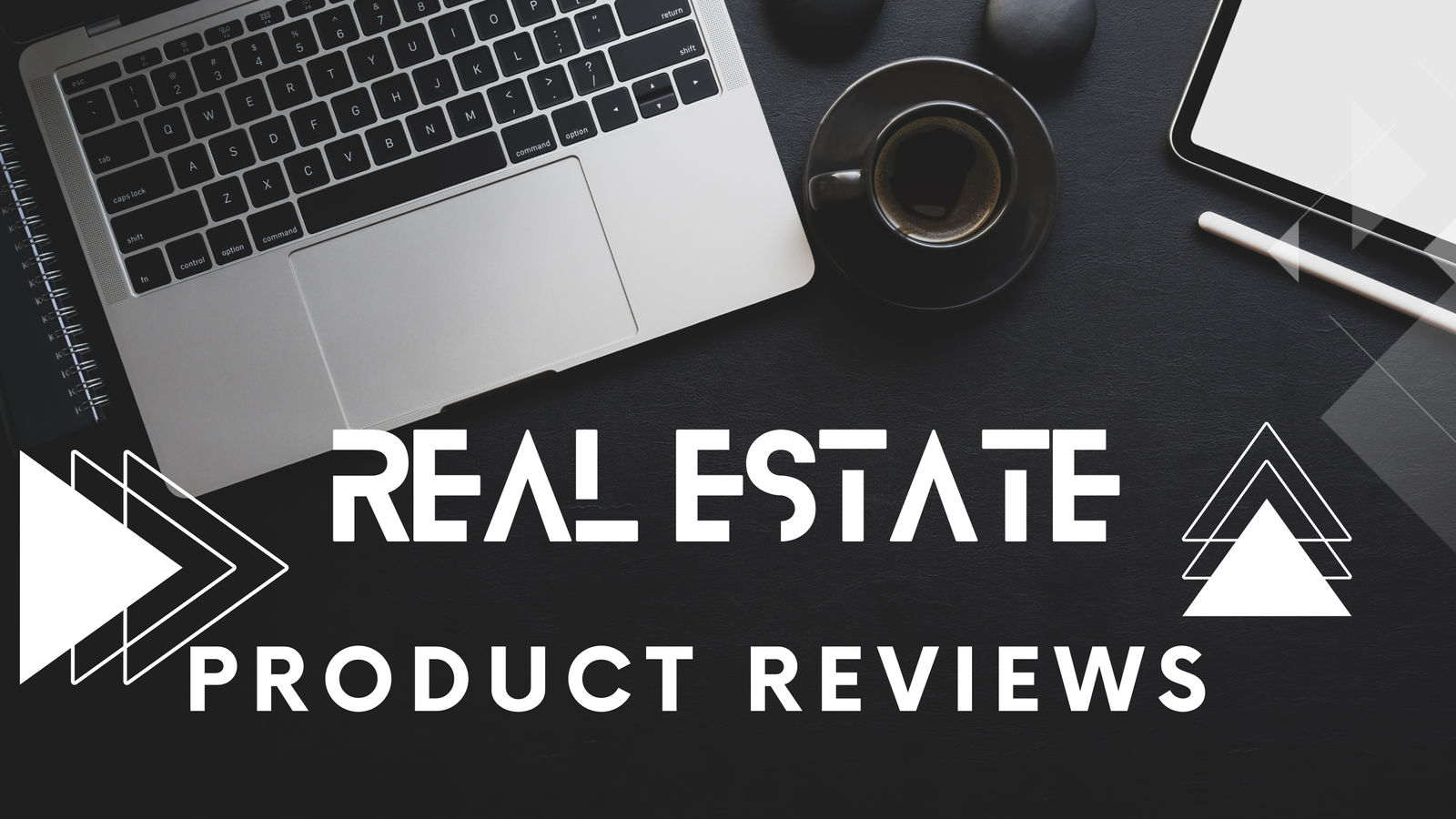To host effective real estate webinars and grow your audience, define clear objectives based on market trends and audience interests, crafting compelling titles to draw attendees. Understand your audience by researching demographics and tailoring content to align with their needs. Engage participants using visual aids, real-life case studies, and interactive elements like polls and Q&A sessions. Promote your webinar through optimized landing pages and targeted marketing campaigns. During the webinar, encourage interaction to maintain interest and gather valuable feedback for improvements. Analyze success by reviewing attendance and engagement metrics, enhancing future webinars. Stay tuned for deeper insights and strategies.
Key Takeaways
- Define clear goals and objectives to align with audience needs and market trends.
- Conduct demographic research to tailor content and ensure relevance to your audience.
- Integrate visual aids and interactive elements to enhance engagement and understanding.
- Promote webinars through email campaigns and social media to maximize reach and participation.
- Analyze feedback and metrics post-webinar to improve future sessions and content delivery.
Planning and Preparation

Preparation is the cornerstone of a successful real estate webinar. You need to start by defining clear goals for your webinar. Ask yourself, what do you want to achieve? Whether it’s educating your audience about market trends or showcasing new properties, having a focused objective will guide the planning process.
Choose topics that aren’t only trending but also relevant to your target audience. Conduct thorough research to gather up-to-date information and reliable sources that will form the backbone of your presentation. Webinars are a cost-effective tool for reaching a broad audience, costing roughly a quarter of in-person seminars.
Craft compelling titles and descriptions that clearly communicate the focus of your webinar while attracting potential attendees. Establish clear learning objectives so participants know what they’ll gain from attending.
When preparing your presentation, design engaging slides using visuals and animations to maintain interest. Include case studies and real-world examples to illustrate key points and provide practical insights. Choosing a reliable platform for your webinar is crucial, as it ensures a smooth experience for both the host and attendees.
Develop a clear call to action, encouraging attendees to take specific steps after your webinar. Prepare additional resources, like downloadable guides, to offer further value.
Identifying Your Audience
Understanding your audience is vital when hosting a real estate webinar. Start by conducting demographic research to identify key factors such as age, profession, industry, and interests. This information helps you create a more targeted approach.
Consider the geographic region where your audience resides, as location plays a significant role in real estate decisions. Income levels should align with your offerings, guaranteeing your content is relevant and appealing. Additionally, grasp the goals and challenges your audience faces in real estate, allowing you to address their needs more effectively. Automation tools can enhance efficiency in marketing and lead generation, which may be beneficial for your audience as they seek effective solutions.
Segment your audience by dividing the broader market into smaller groups based on shared characteristics. Recognize the stage of the buyer’s journey each group is in, which will guide your content strategy. Identify their pain points and the information sources they rely on for real estate insights. Understanding the Ideal Customer Profile (ICP) is crucial in identifying the best-fit customers for your webinar series, ensuring your content resonates with the right audience. Real estate webinars often offer cost-effective education and networking opportunities compared to traditional methods, which makes them appealing to a wider audience.
Consider their criteria and preferences when choosing webinars to guarantee your event stands out.
Researching audience needs is vital. Use surveys and interviews to gather feedback, and analyze social media to spot trends. Conduct market research to stay updated on challenges, and use analytics tools to track audience behavior.
Leveraging this data lets you develop accurate buyer personas and tailor your content accordingly.
Crafting Engaging Content

Once you’ve pinpointed your audience’s needs and preferences, it’s time to focus on crafting engaging content that captivates and informs. Begin by integrating visual aids like slides, videos, and infographics to reinforce key points effectively. These elements will help you convey complex information more clearly and maintain your audience’s interest. To make your content relatable, incorporate real-life case studies and success stories that illustrate your strategies in action. This not only adds credibility but also offers practical examples that your audience can emulate. Selecting a topic relevant to target audience interests is crucial to ensure the content resonates well with attendees. By incorporating interactive elements such as polls and quizzes, you can keep your audience engaged and encourage active participation throughout the webinar.
| Visual Aids | Case Studies | Actionable Tips |
|---|---|---|
| Slides | Real-Life Examples | Step-by-Step Advice |
| Videos | Success Stories | Practical Application |
| Infographics | Illustrative Strategies | Immediate Implementation |
Address common objections by preparing responses to frequent concerns, ensuring your audience feels heard and valued. Support your points with relevant data, like recent statistics or market trends, to further establish your authority. Encourage interaction through live polls, Q&A sessions, and live chat to foster engagement and audience participation. Finally, organize your content with a clear structure, using storytelling and smooth shifts to maintain a logical flow. Conclude with a compelling call-to-action that motivates your audience to take the next step.
Promoting Your Webinar
To effectively promote your real estate webinar, start by harnessing the power of digital platforms to maximize your reach. Begin with your website, creating a dedicated landing page that showcases upcoming webinars. Utilize hero banners on your homepage and blog to maintain consistent visibility. Highlight webinars in product-focused sections, like a “news” area, to catch the eye of potential attendees. Confirm your registration page is optimized with minimal form fields and engaging videos to encourage sign-ups. To maximize engagement, you can increase conversion rates by up to 80% by incorporating a video on your registration page. Leverage email marketing by sending promotional emails 3-4 weeks before the webinar, increasing frequency as the event approaches. Engage with past attendees and new prospects through these campaigns. Tap into LinkedIn groups and forums, sharing your webinar details while adhering to group rules. Ensure your promotional materials and website are mobile responsive to cater to users on all devices. Additionally, consider utilizing email automation to streamline your promotional efforts and ensure timely follow-ups. Encourage your employees to spread the word on social media, creating a buzz around your event. Craft compelling promotional materials with visuals and videos. Record short, informative videos highlighting key takeaways and share them across social media platforms. Use engaging headlines and optimize your content for search results, confirming maximum visibility.
Hosting Interactive Sessions

After effectively promoting your real estate webinar, it’s time to focus on hosting interactive sessions that keep your audience engaged and invested. Start by selecting relevant topics that resonate with your participants. Identify key industry trends, challenges, and common pain points to address. Draw inspiration from popular blog topics, newsletters, and videos, guaranteeing your content aligns with the interests and needs of your audience. Aim to deliver practical solutions that captivate and engage your listeners. Utilize platforms like Facebook Live or Instagram Live to reach a global audience without geographical barriers. Incorporate engaging audience techniques throughout your presentation. Use interactive elements like polls and Q&A sessions to encourage real-time feedback and questions. Initiate conversations with your audience every four to five slides, and leave adequate time for answering questions. Storytelling and personal anecdotes can be powerful tools to maintain engagement and provide relatable context to your topics.
Adopt effective presentation strategies by creating visually appealing slides with minimal text, using case studies, graphs, and infographics to illustrate your points. Practice your presentation in advance to guarantee smooth delivery, using clear and concise language. Choose a reliable webinar platform, test your technology, and conduct dry runs to refine your delivery, enhancing the overall interactivity and professionalism of your session. Remember that audience engagement is crucial for maintaining attention and building brand loyalty, making it an essential focus for successful webinars.
Gathering Valuable Feedback
Gathering valuable feedback is essential for refining your real estate webinars and ensuring they meet the needs of your audience. Start by incorporating post-webinar surveys to assess the effectiveness of your content and delivery.
Use platforms like SurveyMonkey or Google Forms to create and distribute concise yet detailed surveys. Real-time polls and Q&A sessions during your webinars offer immediate insights into attendees’ concerns and interests, fostering engagement and interaction.
Feedback forms on your webinar landing pages can capture attendees’ thoughts while the experience is fresh. Additionally, leverage social media channels to solicit feedback and engage with your audience, creating a dialogue that extends beyond the webinar itself.
Email follow-ups are another effective strategy; send personalized messages requesting feedback and suggestions for future webinars to maintain a connection with your audience.
Utilize feedback data to identify areas for improvement in presentation and content. Refine your topics and delivery strategies based on these insights, and consider adjusting your marketing efforts to better reach and engage your target audience.
Implement suggested interactive elements to enhance future webinars, and share how feedback has led to improvements, building trust and credibility with your audience.
Analyzing Webinar Success

Understanding the success of your real estate webinar hinges on analyzing key performance metrics. Start by examining attendance rates: compare the number of attendees to the registrants. This helps you assess interest and engagement levels, revealing how compelling your webinar topic was.
Next, explore engagement metrics by monitoring polls, Q&A sessions, and chat activity. High participation indicates that your audience found the content compelling and felt comfortable interacting.
Opportunity generation is another significant metric. Count the leads and follow-up conversations sparked by the webinar. This data reflects how well your presentation prompted prospects to take the next step.
Feedback surveys, distributed post-webinar, offer insights into audience satisfaction and pinpoint areas needing enhancement. These surveys are invaluable for understanding your audience’s experience.
Conversion rates are equally important: analyze how many attendees turned into clients or prospects. This figure shows the effectiveness of your sales funnel and webinar content.
Additionally, pay attention to social media engagement. Track mentions and discussions to gauge your webinar’s broader impact. Evaluating your content’s relevance, quality, and takeaway value guarantees it meets your audience’s needs.
- Prepare for Loan Maturities and Refinancing Waves as a Real Estate AgentIn mastering loan maturities and refinancing waves, uncover strategies every real estate agent needs to empower clients during pivotal financial transitions.
Improving Future Webinars
To improve your future webinars, it’s essential to start with well-defined objectives. Begin by setting specific goals, such as generating leads or promoting services, ensuring these align with your audience’s needs. Develop a clear value proposition, so attendees understand the benefits they’re gaining.
Identify key performance indicators to measure success and use past webinar data to refine these objectives, making sure each session is more targeted and effective.
Enhancing engagement is vital, too. Incorporate interactive elements like polls, Q&A sessions, and live chat, which encourage participation and keep attendees interested. Use storytelling to make your presentation more relatable and engaging.
Personalize interactions by using attendees’ names and ask questions to stimulate discussion. Visual aids and animations can also help to illustrate key points and maintain audience attention.
Lastly, gather feedback to continuously improve. Conduct surveys post-webinar to identify areas for refinement. Analyze performance metrics to understand what resonated with your audience.
Adjust content and format based on this feedback, keeping your webinars fresh and relevant. Test different formats to discover what works best, thereby ensuring each webinar is an improvement over the last.
Repurposing Webinar Content

After enhancing your webinars for maximum impact, it’s time to contemplate how you can further extend their reach by repurposing the content. By transforming webinars into blogs or e-books, you enhance your SEO, attract organic traffic, and offer a more digestible format for audiences. Creating bite-sized video clips captures key insights and highlights from the original webinar, making them perfect for social media sharing. Alternatively, develop online courses to help audience members continue their professional education and establish yourself as an industry leader.
Strategically align repurposed content with your marketing goals. Use it to engage webinar no-shows or drive traffic to future events. Transform content into infographics or podcasts, reaching a new audience that prefers visual or audio formats. Showcase expertise through FAQs or white papers, and leverage geo-farming tools to target specific neighborhoods with insightful content.
| Format | Purpose |
|---|---|
| Blogs and E-books | Enhance SEO and attract organic traffic |
| Video Clips | Share key insights on social media |
| Online Courses | Establish brand as an industry leader |
Recent Posts

Sony Alpha 1 Camera Review

How to Show Appreciation to Clients After a Sale
Frequently Asked Questions
How Can Technical Issues During Webinars Be Minimized?
You can minimize technical issues during webinars by conducting dry runs to test your technology and internet connection.
Select reliable platforms with strong technical support and invest in quality equipment like high-performance computers and stable internet connections.
Train your staff and moderators in troubleshooting and have a technical team ready for real-time issues.
Prepare backup plans, such as alternative platforms or redundant equipment, to guarantee seamless changes if problems arise.
What Is the Ideal Duration for a Real Estate Webinar?
The ideal duration for a real estate webinar is typically between 30 to 60 minutes.
You should aim for 60 minutes, as it’s the most popular length that maintains audience engagement, according to Zippia data.
Avoid going beyond 90 minutes to prevent mental fatigue.
Consider the topic’s complexity and your audience’s needs.
Include time for a Q&A session to engage participants and address their questions, ensuring a thorough experience.
How Often Should Real Estate Webinars Be Hosted to Maintain Audience Interest?
You should host real estate webinars every 2-4 weeks to maintain audience interest and engagement.
Consistency is essential, so aim for regular sessions without overwhelming your audience. Promote your webinars at least two weeks in advance to maximize registrations.
Analyzing attendance rates and feedback helps determine the ideal frequency.
Vary topics and formats to keep things fresh and exciting, ensuring your audience remains engaged and looks forward to each session.
What Equipment Is Recommended for High-Quality Webinar Presentations?
To achieve high-quality webinar presentations, you’ll want to invest in reliable equipment.
Opt for a Logitech C920 HD Pro Webcam for budget-friendly video quality or a Canon EOS M50 for 4K resolution. Pair it with a Blue Yeti Nano microphone for clear audio.
Make certain your lighting is ideal with a ring light or 2-point softbox setup. Additionally, use stable internet, a tripod, and consider soundproofing to enhance overall presentation quality.
How Can One Ensure Online Security During Webinars?
To guarantee online security during webinars, choose reputable platforms with robust security features, and use strong passwords paired with two-factor authentication.
Encrypt all data transmissions using protocols like HTTPS, and keep your encryption keys updated.
Control access by requiring verified registrations and using unique meeting IDs.
Monitor for suspicious activity and have an incident response plan ready.
Regularly train staff on cybersecurity best practices to maintain a secure environment.
Bottom Line
By following these steps, you’ll effectively host real estate webinars that not only grow your audience but also foster community engagement. Identifying your audience and crafting engaging content guarantees relevance, while promoting the webinar and hosting interactive sessions keeps participants invested. Gathering feedback and analyzing success offers insights for improvement, making future webinars more effective. Finally, repurposing content maximizes its reach, extending your influence and solidifying your presence in the real estate community.







